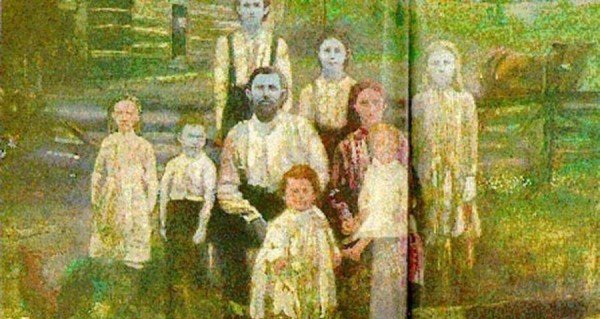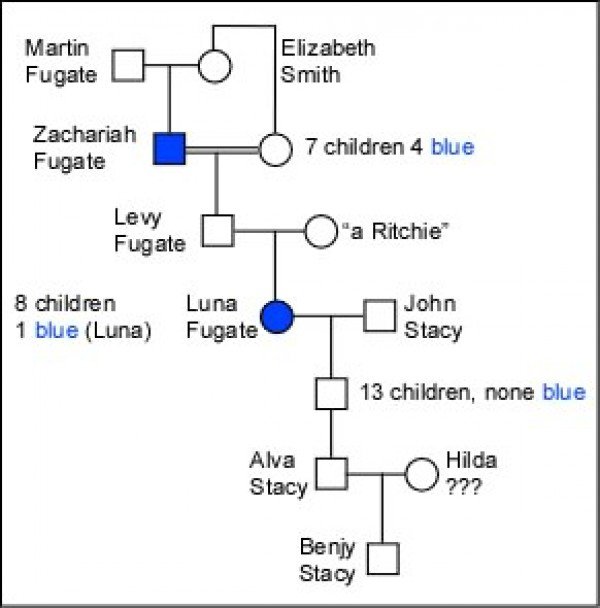For nearly two centuries, the Fugate family of Kentucky passed their unique characteristic of blue skin from one generation to the next. As a result of this weird disorder, they decided to isolate themselves from the community.
The Blue People of Kentucky, also known as the Blue Fugates, have long been of scientific interest.

Page Contents
The Blue People Of Troublesome Creek:
In the year 1820, a French orphan named Martin Fugate arrived in Troublesome Creek, a remote area in eastern Kentucky.
Martin married Elizabeth Smith, who was said to be as pale and white as the mountain laurel that blooms every spring across the creek hollows.
Elizabeth had a rare genetic condition that turned her skin into the blue.
The couple set up house in the Troublesome and started their family. Out of their seven children, four of them had blue skin.
The place where Martin and Elizabeth lived was very isolated, and newcomers were hardly seen. This resulted in a high level of consanguinity in marriage between the families.

When Zachary, one of Elizabeth’s and Martin’s blue color sons, married Elizabeth’s sister, the ailment gene continued to spread.
The clan kept on multiplying. Eventually, this led to many descendants of the Fugates who were born with blue skin genetic disorder.
Martin Fugate married a woman with the same rare genetic disorder he had since childhood. However, before the wedding, he didn’t know about his wife’s syndrome. It was an unfortunate coincidence.
Consanguinity, relationship by descent from a common predecessor, can cause significant genetic disease.
Difficult Life For The Blue Fugates Of Kentucky:
Blue people’s life wasn’t that easy. All Blue Fugates were insulted continuously because of their unusual appearance.
Neighbors used to laugh at the family’s blue appearance. Hence this discrimination resulted in that the Blue family isolated themselves from the rest of the people.
The Blue people of Kentucky had no idea why their skin had this unusual color. Therefore, they just tried to live a happy life. What else could they do?
The family didn’t come across any disease or other health problems except this blue skin gene-disorder that badly affected their lifestyle. They were humiliated about being blue.
Poor Blue-skinned people continued to live in the areas around Troublesome Creek and Ball Creek to the 20th century.
Then, in the 1960s, something finally happened, and this odd medical condition was examined.
The Science Behind The Mysterious Blue Skinned People:
Two members of the Fugate clan approached Madison Cawein III, a hematologist at the University of Kentucky’s medical clinic.
Dr. Cawein was very eager to know more about the Blue Fugates rare disorder. Therefore, he recruited a nurse named Ruth Pendergrass to assist him in his analyses.
Ruth Pendergrass was also keen to work on this case because she had previously met a dark blue woman at the hospital. The blue-skinned woman had come to ask for a blood test, and her unusual appearance shocked Pendergrass.

Medical tests conducted by Dr. Cawein and Pendergrass discovered the truth about the Blue Skinned People of Kentucky. Both of them had a disease called methemoglobinemia.
When levels of methemoglobin in the red blood cell are beyond one percent, skin turns blue. Additionally, the lips become purple, and regular red blood gets a chocolate brown color.
This syndrome can be either inherited or triggered by exposure to chemicals such as benzocaine and xylocaine.
Fugate Family’s Blue Skin Disorder Cured?
The good news for the Blue Fugates of Kentucky was that disease got cured.
Dr. Cawein prescribed them daily methylene blue tablets, and the blue color from the skin got vanished in a few years.
After suffering embarrassment for generations, they could finally enjoy a natural life without being stared at and laughed.
Benjamin “Benjy” Stacy, born in 1975, is the last known successor of the Fugates. He also had blue skin. However, by the age of seven, the color vanished from his skin.
Though today Benjamin and most of the Fugate family descendants have lost their blue color disorder, the shade sometimes comes out of their skin when they are cold or flush with anger.











